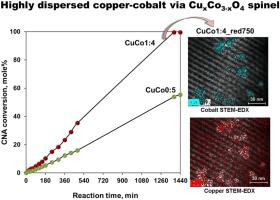Applied Catalysis A: General ( IF 4.7 ) Pub Date : 2021-08-04 , DOI: 10.1016/j.apcata.2021.118303 Carmen Ciotonea 1, 2, 3 , Alexandru Chirieac 2 , Brandusa Dragoi 2 , Jeremy Dhainaut 1 , Maya Marinova 3 , Stephane Pronier 4 , Sandrine Arii-Clacens 4 , Jean-Philippe Dacquin 1 , Emil Dumitriu 2 , Adrian Ungureanu 2 , Sébastien Royer 1

|
The preparation of supported bimetallic materials based on transition metals has attracted much interest since their use as catalysts towards hydrogenation processes for the production of fine chemicals or environmental depollution processes. The synthesis procedure proposed in this study allows to obtain bimetallic materials with high dispersion of the active sites, control of the chemical composition and localization as well as good thermal resistance against sintering. In this line, a series of materials based on Cu and Co supported on SBA-15 were prepared by the optimization of the drying step during incipient wetness impregnation, the ratio of Cu-Co was studied and the monometallic materials were used for comparison. The physico-chemical properties of freshly calcined and reduced materials were investigated by ICP-EOS, nitrogen physisorption, ex-situ and in-situ XRD, TEM-EDX, TPR and XPS. The materials showed improved dispersion at low copper ratio, due to the stabilization of CuxCo(1-x)Co2O4 spinel phase, promoting a high dispersion of confined NPs of 9 nm within the large pores of the SBA-15. Subsequent stabilization of the Cu and Co NPs is observed by in situ-XRD, and the collected HAADF micrographs clearly evidence a high dispersion of the copper within the bimetallic NPs. However, when copper is exceeding the CuCo ratio of 4:1, larger NPs of CuO located outside the silica mesopores are observed. Subsequent catalytic performances were investigated in the hydrogenation reaction of cinnamaldehyde (CNA), in two different pressure regimes (1 bar and 10 bars). For the reaction under pressure, CuCo1:4 showed the highest conversion with 67 mol % after 150 min of reaction, while the selectivity to the cinnamyl alcohol (CNOL) was of 47 mol %. The same catalyst showed a conversion of 99 mol % in atmospheric pressure after 24 h of reaction and the selectivity to CNOL reached 72 mol %. Such results confirm that our modified IWI protocol using mild drying step is valuable towards the preparation of confined bimetallic nanoparticles within mesoporous sieves. High stability of such confined nanoparticles allow reduction of the active elements up to the metallic state, which strongly promotes the catalytic performance towards CNA hydrogenation reaction.
中文翻译:

研究无机介孔筛中 Cu-Co(氧化物)纳米粒子的 3D 空间分布:对肉桂醛加氢催化性能的影响
基于过渡金属的负载型双金属材料的制备引起了很多兴趣,因为它们用作生产精细化学品或环境净化过程的氢化过程的催化剂。本研究中提出的合成程序允许获得具有高活性位点分散、化学成分和定位控制以及良好的抗烧结耐热性的双金属材料。在该生产线中,通过优化初湿浸渍过程中的干燥步骤,制备了一系列以Cu和Co为载体的SBA-15材料,研究了Cu-Co的比例,并使用单金属材料进行了比较。通过ICP-EOS、氮物理吸附、异位和原位 XRD、TEM-EDX、TPR 和 XPS。由于铜的稳定性,材料在低铜比下表现出改善的分散性x Co (1-x) Co 2 O 4尖晶石相,促进 9 nm 受限纳米粒子在 SBA-15 的大孔中的高度分散。随后通过原位 XRD 观察到 Cu 和 Co NPs 的稳定化,并且收集的 HAADF 显微照片清楚地证明了双金属 NP 中铜的高度分散。然而,当铜超过 4:1 的 CuCo 比率时,观察到位于二氧化硅介孔外部的更大的 CuO NP。在肉桂醛 (CNA) 的氢化反应中,在两种不同的压力范围(1 巴和 10 巴)下研究了随后的催化性能。对于加压反应,CuCo1:4 在反应 150 分钟后显示出最高的转化率为 67 mol%,而肉桂醇 (CNOL) 的选择性为 47 mol%。相同的催化剂在大气压下反应 24 小时后的转化率为 99 mol%,对 CNOL 的选择性达到 72 mol%。这样的结果证实,我们使用温和干燥步骤改进的 IWI 协议对于在介孔筛内制备受限双金属纳米粒子是有价值的。这种受限纳米粒子的高稳定性允许将活性元素还原为金属态,这有力地促进了对 CNA 加氢反应的催化性能。











































 京公网安备 11010802027423号
京公网安备 11010802027423号